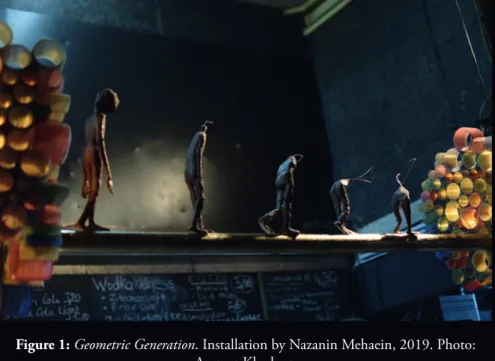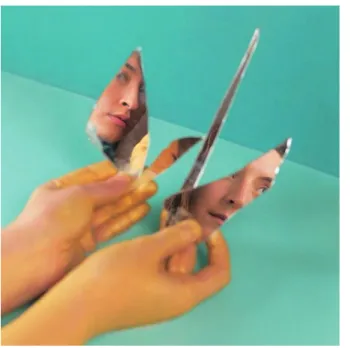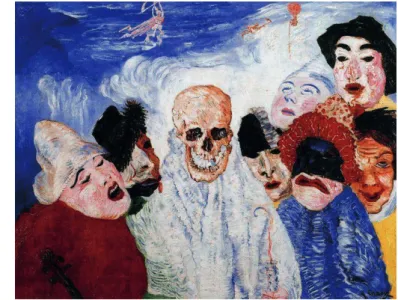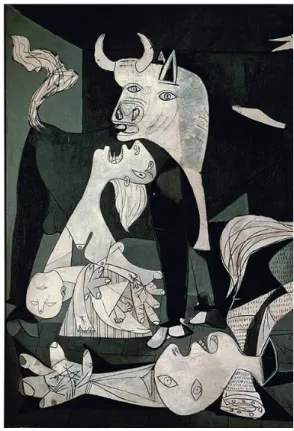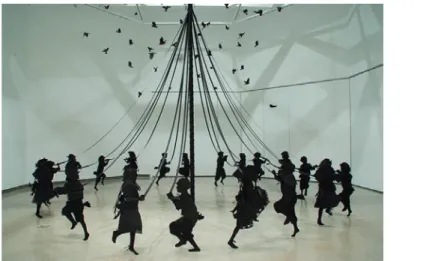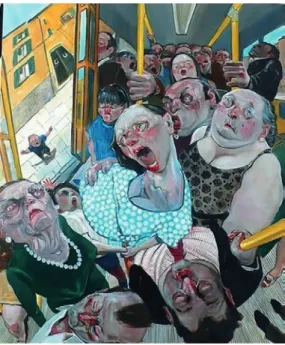Shiva Massoudi
University of Tehran (Tehran - Iran)2 Nazanin Mehraein
University of Applied Arts Vienna (Vienna - Austria)3
Key words: Image. Painting. Dramaturgy. Directing. Puppetry Performance. Inter-disciplinary art.
1 Based on: Directing course, imaged-based dramaturgy by Shiva Massoudi’s Course year 2018-19.
2 Ph.D of Theater, The Head of M.A of Puppet Theater, University of Tehran, Iran. 3 BA Puppet theatre, Tehran, Iran, current M.A Transdisciplinary Arts, University of applied arts Vienna, Austria.
Figure 1: Geometric Generation. Installation by Nazanin Mehaein, 2019. Photo: Ammar Khadoor.
R
evista de Estudos sobr
e Teatr o de F or mas Animadas DOI: http://dx.doi.org/10.5965/2595034701202019237
Abstract: Undoubtedly, it is impossible Teaching any kind of Art without contemplating the others. Based on dissolving the borders of different kinds of arts then interdisciplin-ary trends is so prevalent in Contemporinterdisciplin-ary art. The appearance of elements of other kind of Art like Photo, video in Theatre emphasizes on revising method of teaching. In Puppet Theatre which has essentially synthetic quality of performance with different styles of manipulation and animation up to any Artist, this issue is very important. The entrance of new media to puppet theatre have been more strong and effective because of some overlapping aspects between puppet theatre and cinema, painting and etc. To harmonize with new interdisciplinary art revising teaching method especially in directing course as final step is necessary. Image has significant and crucial role in our current life and culture. The appearance of virtual media in life of humans, makes image the strongest and closest communication channel with the world. Then creating and then reading image is fundamental for artists as well as audiences and naturally must be learned in all kinds of visual art or performing art. Reading image has three step which include from exact observation to pull out motifs and symbols and finally search about characteristic of images which relate the world of image to other worlds. Reading an image could help to implied direct or indirect meaning of an image and use it as a dramaturgical adaptation meaning, transformation it as a text to create a piece. Directing course in Puppetry academy mostly is final course in which student prepare a performance. Teaching directing divided in two skills: Technical directing and Artistical directing. In Technical directing students learn technical aspects of directing
R
evista de Estudos sobr
e Teatr o de F or mas Animada s
but Artistical directing is about director’s approach, the insight of director. Starting with image is a good method for teaching Artistical directing and improve directing approach. This method could help the students to learn making meaning, to learn better seeing, to learn creative looking and reveal hidden meanings. this is applied in stage directing class for puppetry student in B.A and have 4 steps which is start by a selective painting. In first step painting is introduce as a text and adopted to puppetry performance. second step is first part of Dramaturgy which is analyzing painting and has six stages. Third step is second part of dramaturgy which is making narration or story and in last step the student search for a puppetry visualization. By achieving the narration and finding the puppetry visualization, the process of rehearsal begins. Also, in this process, light, sound and music are designed and finally each student show his performance which maybe goes toward innovative styles, or different theatre forms including object theatre, digital theatre. This method Improving image-mind skills, improving dramaturgical skills, introducing painting (or photo) as a new material for creating puppetry performance and Emphasizing on the strength (power) of Puppet Theatre as a kind of performing art which can embrace all modern approaches.
Key words: Image. Painting. Dramaturgy. Directing. Puppetry Performance. Inter-disciplinary art.
R
evista de Estudos sobr
e Teatr o de F or mas Animadas Introduction
It goes without saying that at this time, because of dissolving the borders of different kinds of arts, it’s impossible to teach a special artistic field without contemplating other. As a result, many modern artistic activities devote to interdisciplinary art in which different kinds of art are merged as a whole kind. Using new Medias like photo, video and etc., in an art form like theatre, shows us teaching methods of artistic fields should be revised.
Because of synthetic essence of puppet theatre, this issue is more important which consist of various sections like drawing, painting, sculpturing, dancing, animating and etc. Also its essential diversity shows itself in different styles of puppet theatre which can be in-creased by creative ideas of artists. The entrance of new media to puppet theatre have been more strong and effective because of some overlapping aspects between puppet theatre (shadow theatre) and cinema. It seems for synchrony with contemporary interdisciplinary art improving and revising the method of teaching Puppet Theatre, especially stage directing as a final process, and is necessary.
The Importance of Image
“The principles of true art is not to portray, but to evoke.” Jeresy Kosinsky, from The Principles of True Naturally what connects most of different kinds of arts is
im-age which is the main element in visual arts, performing arts and new media. Beside artistic goals, today, image is the most effective instrument in advertising and plays an important role in nowadays commercial world.
Image, as a painting or a frame of photo is a medium which connects art, society and people to each other.
Hereinabove, the appearance of virtual media in the life of hu-mans makes image the strongest and closest communication channel
R
evista de Estudos sobr
e Teatr o de F or mas Animada s
with the world. Thus creating images and then reading them is the most essential work for producers (including artists) and viewers (including audience).
As image itself is being a strong connecting element between different art medias/mediums and society, art students and especially students of puppet theatre, first reading it and then comprehending it takes a place as an important skill too. Based on those skills one could create an image too. Creating an image is not only creating an induvial frame of a photo or a painting but also could be to create a source of dramaturgical inspiration for a play in theatre. Or a visual inspiration base for being alive in 3 dimensional world of sculpting. It could be a creation based on a natural reality- simply a landscape- which inspires a composer to produce a music piece and etc.
To be able to comprehend an image, we need to follow rules and be able to read it. To read an image itself, is individual and separated from what artist or image-creator wanted to say. To learn the skill how to read an image please study the instruction further.
The Steps of Reading Images:
First step is natural OR visual basic reading which clarify the direct visual meanings in a painting or a frame of photo. Let’s say as soon as we see a painting or a frame of photo, we give up understanding it or analysing it. To read a visual, especially on first step is opposite of studying it and it’s more being eyes for an exact observation. Take your time. Watch the elements of the visual frame. Stop relating it to any other meaning. See the elements in the most basic way, they are. Example: is the line straight or curved?
Zoom in and out. Relax your eyes in observation and try to understand the quality of details without and association. Attention: don’t get lost in sense of beauty and aesthetic. Observation of lines, shapes, colours, textures, composition and the relationship between them BUT eyes functioning same as a camera. A photo frame we chose, could be a frame of life and has nothing to do with theatre. The painting could be an inspiration for a scene, which could shape the whole piece.
R
evista de Estudos sobr
e
Teatr
o de F
or
mas Animadas
Figure 3: Parts (2015), Maren Celest. Source: http://marencelest.com/new-page-1
Figure 4: Étude de Nu (1882), Henri de Toulouse-Lautrec. Source:
https://www.artri- bune.com/arti-visive/arte-moderna/2017/12/mostra-toulouse-lautrec-palazzo-reale-mi-lano/attachment/p_78/
R
evista de Estudos sobr
e Teatr o de F or mas Animada s
Second step is to pull out the motifs and symbols. In terms of specific subject matter, the symbol could be combination of cultural elements, religious mysticism, the perverse, the erotic, and the decadent. This step is like a bridge from step 1 to 3. Example: simply ‘cross’ in renaissance painting.
Third is essential meaning which searches about national, historical, moral, philosophical and other characteristic of images which relate the world of image to other worlds. What happens there? Is there a story what we know from our life too?
Here is our safe zone as we get more knowledge. Travelling, reading, aging could be reasons in which we get master of reading an image and analyse with all details behind the curtain. As an example we could read: Death and The Masks.
Figure 5: Death And The Masks (1897), James Ensor.
R
evista de Estudos sobr
e
Teatr
o de F
or
mas Animadas
The Results of Reading Images:
• Understanding the images and their direct and implied meanings.
• To adopt dramaturgical meanings of an image as a medium and transform it into another medium as texts which could be a base for a performance.
• Improving the creating image skill, in basic simple ways, by using what is learnt in reading image. (Let’s say there is no need to be a professional painter or photographer; what’s important is empowering your skill in reading images.) The importance of image and the matter of
interdisciplin-ary art, encourages students and young artists to work more with transforming mediums to each other.
Puppetry is one of the most rooted and basic kinds of perform-ing art. It’s been not invented but brought from old rituals and tradition which existed for ages into the form which we have now. How to find a new method to harmonize puppetry in con-temporary art with a new dramaturgical approach of ‘reading an image and transforming it’, is the question we are going to answer.
Importance of practical training to students
In every university, puppet theatre is determined courses which must be passed in different phases. Mostly stage directing is one of the final course, in which students prepare a performance as a director, by using all the skills they already have leant. This course divides in two major skills; Technical directing and Artistical directing.
Technical directing in which students learn technical aspects
of directing like using dimensions of stage, composition (toward actors and objects), puppet movements, relationship between puppet and puppeteer, etc. Any problem which relates to physical aspect of stage directing is known as technical skill of director.
Artistical directing which is about director’s approach, the insight of director, how he sees the world.
R
evista de Estudos sobr
e Teatr o de F or mas Animada s
Artists as social leaders and reflections need to: see farther and deeper than the others and help people by criticizing, showing correct way, being better humans for the world an etc.
In classic discourse of teaching stage directing (in Iran for instance), usually, students lead to select a text (play) and direct it as a puppet performance or one technique of Puppet manipulation (marionette, muppet, etc.) is selected and each student must make a performance based on that technique. Clearly none of this methods could improve directing’s approach well because their emphasis is on technical aspects. They are simply wrong way of repetition same theatrical order: This is what you must do as a director!
Yes! To adopt a written play and have a new approach towards it, could also open some doors BUT in nowadays art movements, destroys student creativity and takes us steps backwards in directing courses which are already being studied at first when we step into theatre studies.
Also in this classical methods, there is a little space to empower transformation art mediums as it is in interdisciplinary art. It seems new methods must be found which could improve directing insight, in students, students and can move them beyond the borders of different art mediums. This method could help the students to learn making meaning, to learn better seeing, to learn creative looking, to learn deep thinking and reveal hidden meanings. Image is a good base for starting new method.
Method-step 1: Painting4
This new method is applied in stage directing class for pup-petry students in which hopefully they learn directing approach and insight, which called artistic directing.
At the end of this class each student must perform a puppet 4 Art analysis | The Panofsky method, Yolanda Silva | Online courses: Analysing Art and Iconography of the Saints
R
evista de Estudos sobr
e Teatr o de F or mas Animadas performance.
We keep our example for now based on selection of a painting which is selected as an image for starting point. The selection of a painting is because of some reasons which fulfils the two main goals of this revising method: the improving of directing insight and the importance of interdisciplinary art trends.
• Painting is introduced as a text. • Painting is a visual artistic work.
• Painting is adopted to a (puppetry) performance.
These three comments can connect painting to our goals. Painting as a text leads the student to read, analyse, explicate and interpret, all of which help him/her to think better and deeper and find an accurate approach and good analysis to use painting for a performance. Painting as a visual artistic work puts this activity from starting point as an interdisciplinary space as it floats between painting and puppet theatre. So naturally the final performance could go toward to interdisciplinary arts. Obviously fantastic or imaginary painting is more suitable to the marvellous world of puppet theatre.
The painting could be an inspiration for a scene, which could shape the whole piece. It could be a portrait which reminds a character and could be a landscape which connects us to a special features of a place with a story and etc.
Method-step 2: Dramaturgy (Analysing the Painting)
Dramaturgy in whole meaning is the process between the text (idea or play) and performance. In this method, dramaturgy has two parts: First is analysing the painting and second is making
narration (story) based on the painting.
Listen to the poetic way in which Susan Woodford analyses or tells the story of Guernica, Pablo Picasso’s painting:
“…her distorted face is a mask of pain – a doubted scream- makes it more visible. The dead baby hangs like a puppet from her arms,
R
evista de Estudos sobr
e Teatr o de F or mas Animada s
asleep and lifeless, in a way that his nose pulls toward the ground…” 5 The way Prof.Woodford describes Guernica could easily be part of a play OR it could be a base for a text’s dramaturgy. This type of analyse could be material for Step 3!
Now back to the steps!
Figure 6: Guernica (1937), Pablo Picasso. Source: https://www.pablopicasso.org/ guernica.jsp
As we mentioned before, reading an image has three steps. Based on these three steps, analysing the painting can be categorized in six stages which lead the student to complete, accurate and personal analyse of reading the painting. This six stages are:
R
evista de Estudos sobr
e
Teatr
o de F
or
mas Animadas
• Recognizing painting as a visual work and studying its formal elements and its style (This can be done by the help of a master of visual arts who can lead the students to the formal analysing of painting).
• Perception of the visual signs of painting related to the historical, social and artistic age which can show the connection of painting to the temporal horizon and the influence of artistic style, social and political situation of the creating time of the painting.
• Comprehension of the narrative process of painting: starting, middle and ending point. In other word drawing subjective line which go through painting (from staring point to ending point) for finding narration line.
• Extraction implied meanings of the painting by considering the formal elements and its signs.
• Using historical, psychological, social, semantical and allegorical reading for interpretation of the painting and filling its narrative gap.
• Achieving to a specific analysing reading of the painting which will be the perception or adaptation of each student’s mind. If these six processes in reading the painting can be done in a team work’s activity, it will have great results because of using col-lective intellect (mind). In this way, everyone adds something and clarifies painting based on his perspective and knowledge which can result in completing and deep perception about the painting.
Method-step 3: Dramaturgy (Making Narration/Story)
The second part of dramaturgy is making narration or story based on painting which must be consonant with analysing reading which had been realized in pervious step. This narration which can be fiction or nonfiction like an adaptation (a play) could be done in three formats:
R
evista de Estudos sobr
e Teatr o de F or mas Animada s
has keeps complete similarities to narrative process of the painting (from start to ending point).
• Making narration which holds whole basic meaning of painting based on the social and artistic sign of it.
• Making narration with emphasis on implied meanings of the painting based on historical, psychological, social, semantical and allegorical reading.
All of these narrations (fiction or nonfiction) must have been structured with: beginning point, middle point and ending point.
In our experiences, teaching this course, some students who are interested in writing created a complete play based on their chosen painting and some of them just had a subjective idea which could perform it without any written text. Anyways, making narration is a step where they could learn how to tell their story based on the material (image-based words) which they collected from previous step or adopted till now.
Method-step 4: Searching for Puppetry Visualization
After achieving a narration, the next step is searching for best
puppetry style to reach our aim and improve and spread it in all play’s features. This style, technique or visualization must be drawn based on these themes which have been described in the beginning part: Reading Image.
• Based on formal elements of painting: lines and shapes, tones of colours, texture and composition.
• Based on artistic style of painting which means the puppetry visualization can be harmonized with the style of painting (like expressionism or surrealism).
• Concrete example is to use the same style in stage design, customs, colours and even in the arrangement of the scenery. • Based on historical, psychological, social, semantical and
allegorical reading of painting and study about which style or technique is suitable for each kind of this reading.
R
evista de Estudos sobr
e
Teatr
o de F
or
mas Animadas
• Based on final narration and searching about which kind of visualization can formed the narration completely and deeply. In this step sometimes puppetry visualization goes toward in-novative styles, or different theatre forms including object theatre, digital theatre (using photo and video projection, smart mobile phone possibilities), combination with film, using the architectural space, all for creative visualization of painting.
Performance
By achieving the narration and finding the puppetry visual-ization, the process of rehearsal begins. Also in this process, light, sound and music are designed based on the same elements. Harmony and necessity are the most important rules here.
If we already adopt as enough as possible from the painting we should use the other pre-production elements, as light and sound, either -0- or as minimal as possible.
Remember! We could break the border of combination till the limit of Harmony! Listen carefully to the other elements and especially text. Duration is an important element in keeping our work in balance! Sometimes using more than one strong medium with a long duration, is unnecessary and we should avoid it!
After performing preferably all students attend in a discussion meeting where they can negotiate about the relationship between painting and performance and analysing the accuracy of these process, they could give feedbacks and decide on what they add or delete. This steps helps to make things clear and clean.
Conclusion OR practical results of the course
Actually this course is being taught by me in directing course and here are some of my results:
• Improving image-mind skills which is essential in these days: by image mind, we actually mean visual mind or a mind which is visualised. To read an image (even before entering theatre rehearsal phase) rescues student’s minds
R
evista de Estudos sobr
e Teatr o de F or mas Animada s and clichés.
Data base the chose to make a piece changes and helps they recognise objects as part of frames which their mind and eyes make and prepares mind for being creative in writing, manipulating and specially scene design.
E.g. students those are trained with reading image, catch up quicker with urban life’s unique moments and they creatively make frames. Their eyes are more open and their memory is more activated to save life’s moment to use later in theatre.
This first one is the most important one because of saturation of digital age with images and really bad ones specially in social media. (e.g. Instagram)
• Improving dramaturgical skills, particularly storytelling based on a medium (here as material) as painting as start-ing point.
• Introducing painting (or photo) as a new material for creat-ing puppetry performance. (Gocreat-ing back to the beginncreat-ing, mediums are merging into each other’s.)
Emphasizing on the strength (power) of Puppet Theatre as a kind of performing art which can embrace all modern approaches and trend because of its essential interlacing characteristic.
At the end, to open our lens wider, we mention that big puppetry movements got usually succeed with being separated from those normal limitation: usual theatre hall, usual theatre plays, and usual puppetry techniques. They have been enough brave to break rules same as Peter Schumann in Bread and Puppet. He is one of the best examples of bringing so many elements from painting to theatre. “…Theory of site-specific puppetry which belongs to all people and sound and painting could enter into it without any difficulties…”6 Exemples: Phillipe Genty, Natacha Belova, Duda Paiva, etc.
The other way around, those who bring puppets in painting 6 Andrew Ryder Article about Peter Schumann/Bread and Puppet
R
evista de Estudos sobr
e
Teatr
o de F
or
mas Animadas
and sculpting, e.g. Kiki Smith and Kara Walker.
About Kara Walker’s work, which is playing with puppetry and sound in installation medium we read in “50 Contemporary Artists”:
Figure 7: Black Out: Silhouettes Then and Now by Kara Walker, at the National
Portrait Gallery in Washington, D.C. Source: https://npg.si.edu/exhibition/black-out-silhouettes-then-and-now.
“The shadows of past grow in Walker’s images into new life. Her silhouettes confront the viewer with the painful reality of Af-ro-American history and use contemporary stereotypes.”7
Mediums are merging, digital arts (mapping, robotic, AI) opens space and we –as puppetry directors/ theatre directors- should chal-lenge ourselves with changing our sources of inspiration, embrace this change and develop to next level. To start our new dramaturgical approach, we could learn how to read a painting or a photo frame! Photos from atelier of Shiva Massoudi, Faculty of Performing Art and Music, University of Tehran, Iran:
7 50 Contemporary Artists You Should Know, Brad Finger and Christiane Weidemann, Prestel publisher, 2005, Germany.
R
evista de Estudos sobr
e Teatr o de F or mas Animada s
Figure 8: A painting by Enrico Robusti.
Figure 9: Imaged-base puppetry performance The Night in The Hotel by Saba Ghad-imi. Photo: Mohsen Gilakzadeh.
R
evista de Estudos sobr
e
Teatr
o de F
or
mas Animadas
Figure 10: A painting by Enrico Robusti.
Figure 11: Imaged-based puppetry performance Eye Perspective by Ryhaneh Bara-ghani. Photo: Ateyeh Amiri.
R
evista de Estudos sobr
e Teatr o de F or mas Animada s REREFENCES
WOODFORD, Susan. Looking at Pictures: Art Essentials Series
(Art Essentials). Londres: Thames & Hudson, 2018. RYDER, Andrew. Peter Schumann: Puppets, Bread and Art. 1995.
Disponível em: https://www.sagecraft.com/puppetry/papers/ Schumann.html
FINGER, Von Brad; WEIDEMANN, Christiane. 50
Zeitgenös-sische Künstler. 2005.
